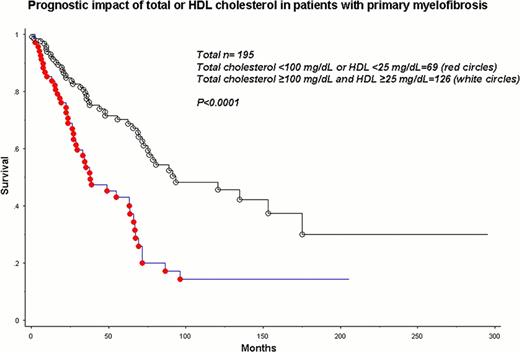Abstract
Abstract 2851
It is widely appreciated that total cholesterol (TC) and triglyceride (TG) levels are decreased in patients with primary myelofibrosis (PMF). However, a systematic study looking into the serum lipid profile in PMF and its phenotypic and prognostic relevance is lacking.
An updated Mayo Clinic database of 1008 karyotypically- and DIPSS-plus-annotated patients with PMF was used to identify study patients in whom serum lipid and lipoprotein levels were available at time of referral. Overall (OS) and leukemia-free (LFS) survivals were calculated from the time of referral, which was also the time of serum lipid analysis.
A total of 207 patients met the above stipulated criteria and had measurement of TC (n=207), TG (n=204), HDL cholesterol (HDL-C) (n=187), LDL cholesterol (LDL-C) (n=176) and non-HDL cholesterol (N-HDL-C) (n=184). The corresponding median (range) values (mg/dL) were 132 (57–296), 147 (42–742), 31 (8–96), 67 (11–186) and 104 (7–249). TC was significantly (P<0.05) lower in the presence of male sex, older age, red cell transfusion need, hemoglobin <10 g/dL, marked splenomegaly, circulating blasts, constitutional symptoms, JAK2 V617F, and ASXL1 mutations. TG was significantly (p<0.05) lower in the presence of JAK2 V617F, red cell transfusion need, hemoglobin <10 g/dL and thrombocytosis. DIPSS-plus risk categories showed significant differences in their TC (p<0.0001), HDL-C (p=0.004), LDL-C (p=0.004), and N-HDL-C (p=0.009) profiles with higher levels seen in lower risk patients; there were no correlations with TG levels.
In univariate analysis, lower levels of TC, HDL-C, LDL-C and N-HDL-C were all associated with shortened survival (P<0.01 for each association) whereas survival was not affected by TG level (p=0.42). Multivariable analysis in the context of DIPSS-plus confirmed the independent prognostic relevance of both TC (p=0.05) and HDL-C (p=0.02) for OS. A similar analysis disclosed no correlation with LFS. Exclusion of patients receiving statin or other anti-lipid treatment did not affect the overall results. Patients in the lower quartiles for either TC (approximately <100 mg/dL) or HDL-C (approximately <25 mg/L) compared to those with higher levels displayed significantly shorter survival (Figure; RR 2.4, 95% CI 1.6–3.7; p<0.0001) that was not accounted for by DIPSS-plus (RR 1.6, 95% CI 1.1–2.5; p=0.03).
Decreased levels of total or HDL cholesterol in PMF cluster with adverse disease features and carry a DIPSS-plus independent adverse prognostic value. Measurement of TC and HDL-C in PMF might be useful in monitoring disease progression and treatment response.
No relevant conflicts of interest to declare.
Author notes
Asterisk with author names denotes non-ASH members.


This feature is available to Subscribers Only
Sign In or Create an Account Close Modal